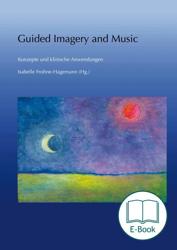Guided Imagery and Music (GIM) - Concepts and clinical Applications, ed. by Isabelle Frohne-Hagemann deals with the more recent developments in Germany of this psycho- and music therapeutic method developed by Helen Bonny in the USA. Different authors reflect in 14 chapters on theoretical and practical positions exemplifying them with the help of case studies and showing by that the further development of GIM since its beginnings.
Guided Imagery and Music (GIM) is a integrative and psychodynamic psychotherapy developed by Dr. Helen Bonny in den late sixties of the last century. GIM works with classical music also integrating spiritual and transpersonal dimensions. GIM is taught and implemented worldwide. In contrast to other receptive forms of music therapy where the verbal exchange of the music experience takes place after having listened to the music, the specificity of GIM is the continuing dialog between the therapist and the client while listening in an altered state of consciousness.
During his „music journey“ the client stays in the here and now and is alive to the importance of confronting his/her conflicts by conducting him/herself through the imagery with help of the music and the verbal interventions of the therapist (instead of reporting his/her experiences afterwards).
This volume presents new developments in GIM and methods of music imagery in German speaking countries and invites to discuss them. The reader is encouraged to deal with different themes and controversial issues like f. ex. how GIM therapists with different therapeutic backgrounds (depth psychological, transpersonal, systemic, etc.) explain and treat psychological disorders with GIM; how can GIM support mentalization; which role does spirituality play as psychotherapy or in psychotherapy; or in general: which influence has the digital age on therapeutic values. The authors investigate when, for whom and why the Bonny Method of GIM or modified forms of GIM and music imagery are indicated. 14 chapters written by 14 authors concentrate on concepts, clinical applications and training.
Part 1 Concepts
Isabelle Frohne-Hagemann: Guided Imagery and Music – GIM in a changing society
Dorothea Dülberg: Investigations on Affective guided Imagery and - Guided Imagery and Music
Anna E. Röcker: Alchemistic Symbols as defined by Jung in Guided Imagery and Music (GIM)
Wolfgang Fasser: GIM and Spirituality
Isabelle Frohne-Hagemann: Definitions und applications: GIM, modified GIM und Musik Imagery
Gina Kästele und Dorothea Müller: Short Music Journeys (KMR): A Gate to the Inner World
Part 2 Clinical Applications
Ruth Liesert: GIM with psychosomatic inpatients – Experiences and considerations in regard to the concepts of
mentalisation
Pia Preißler: A trustful vision of the sea - A case work from psycho oncology
Ruth Hertrampf and Dorothea Schönhals-Schlaudt: Guided Imagery and Music and Group Music Imagery
in the treatment of cancer sufferers
Gudrun Bassarak: Youngster-GIM (YGIM) in the treatment of children and adolecents suffering from psychosomatic
diseases in an ambulant and hospital setting.
Cordula Dietrich: GIM in the ambulant treatment of trauma and grief
Gert Tuinmann: Biofeedback and GIM in the treatment of patients with somatoforme dysfunctions
Part 3. Advanced training
Julie Exner: Onsite Supervision in “Reflective Team Work” (OSS-RT) as part of the advanced training in Guided
Imagery and Music
AMI-certified GIM Trainings in Germany
„Das von Prof. Dr. Isabelle Frohne-Hagemann herausgegebene Buch "Guided Imagery and Music - Konzepte und klinische Anwendungen" beinhaltet eine aus verschiedensten Perspektiven heraus fundierte Zusammenschau aktueller deutschsprachiger Konzepte und Modifikationen der in den USA von Helen Bonny entwickelten Methode Guided Imagery and Music (GIM). Besonders hervorzuheben ist die kritische Diskussion einzelner Aspekte der GIM durch die jeweiligen Autoren. Daneben vermitteln die klinischen Anwendungen vielfältige und anschauliche Einblicke in die komplexe Arbeit mit GIM und deren Modifikationen. Dieses Buch versteht sich laut
Herausgeberin darüber hinaus als Ergänzung und kritische Reflexion des 2010 erschienenen Buchs ,Lehrbuch Guided Imagery and Music' von E. Geiger und C. Maak.“
Von Dipl. Musiktherapeut Thomas Schrauth
In: socialnet,
http://www.socialnet.de/rezensionen/16730.php, 18.12.2014.
Prof. Dr. phil. Isabelle Frohne-Hagemann, geb. 1947 in Hamburg, Volks- und Realschullehrerin, Privatmusikerzieherin, Heilpraktikerin, approb. Kinder- und Jugendlichenpsychotherapeutin, integrative Musiktherapeutin zertifizierte Lehr-Musiktherapeutin DMtG, Lehrtherapeutin der Europäischen Akademie für Biopsychosoziale Gesundheit Hückeswagen (EAG/FPI), dort Lehr-Supervisorin sowie an der Süddeutschen Akademie für Psychotherapie Bad Grönenbach , Fellow (F-AMI) und Ausbildungsleiterin (AMI) für Guided Imagery and Music.
Aufbau und Leitung der Weiterbildung in Integrativer Musiktherapie an der Europäischen Akademie für biopsychosoziale Gesundheit in der Trägerschaft des Fritz Perls Instituts (1982-2002), dort weiterhin als Lehrtherapeutin tätig. Seit 1975 Dozentin an der Hochschule für Musik und Theater Hamburg, seit 2007 dort Professorin für Rezeptive Musiktherapie/Guided Imagery and Music am Institut für Musiktherapie der Hochschule für Musik und Theater Hamburg;
Leiterin des Instituts für Musik, Imagination und Therapie Berlin (IMIT) und der Weiterbildung in GIM; eigene Praxis für Psychotherapie, Musiktherapie und Supervision. Ehrenmitglied der Deutschen Musiktherapeutischen Gesellschaft (DMtG), Mitglied der Ethikkommission der DMtG sowie Redaktionsmitglied des Jahrbuchs Musiktherapie der DMtG, zahlreiche Publikationen.


 Table of Contents
Table of Contents